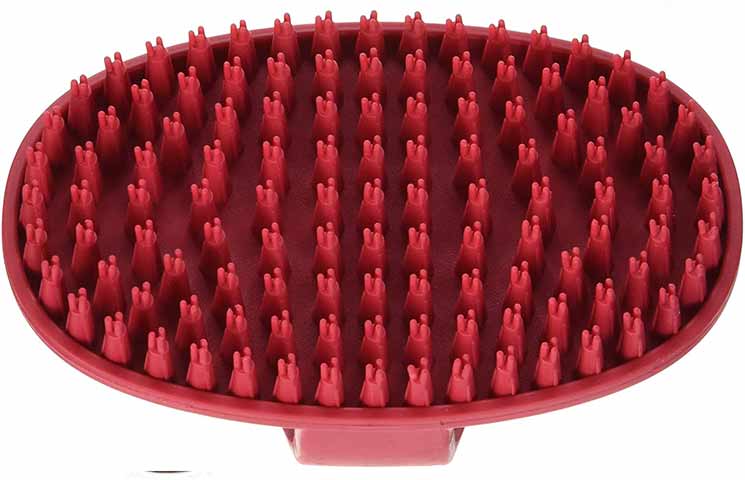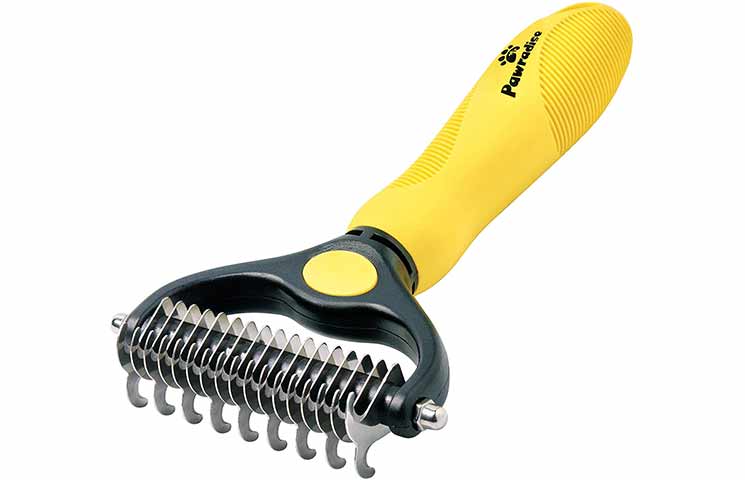There are several dog brushes, combs, rakes and deshedding tools that can be used when grooming your dog. All these grooming accessories are differently designed and have varying functions. They’re also meant for different coat types
Dog grooming brushes can be broadly classified into slicker, pin, soft bristle and rubber or glove brushes. Combs can be categorized into general grooming, dematting and flea combs while rakes can be either undercoat or standard.
Brushes
Here are several varieties of dog brushes and their uses as well as their pros and cons clearly outlined:
Slicker Brush

Slicker brushes consist of fine short wires that are packed closely together. They are used on dogs with medium to long hairs such Yorkshire terriers, Golden Retriever and poodles among others to get rid of mats, tangles or even knots. This type of brush is also used on dogs with curly hairs or even wiry hairs.
There are precautions that need to be taken when using the slicker brush. First, do not apply too much pressure on when brushing your dog, this is because a slicker brush has sharp bristles so when much pressure is applied, the brush might scratch your dog’s skin. This leads to discomfort of the dog and sometimes the dogs might get aggressive.
Second, a slicker brush is not ideal for dogs with issues with their skin such as skin problems, flea bites or broken skin. Once the skin is scratched by the brush on areas with these issues, it might cause irritation to the dog. It could also lead to infections.
It is also important to know the length of your dog’s hair. This brush might not work so well in short haired dogs.
There are several advantages and disadvantages of this type of brush as outlined below:
Advantages
- It is easy and convenient to use.
- It is ideal for removal of dead hairs, mats, debris and also entangles that get formed on the coat.
- It can be used on both dogs and cats thus saving on costs on purchase.
- It is a good deshedding tool thus avoids dog hair being spread all over your home.
- This brush helps stimulate good blood circulation and additionally help spread the dog’s natural oil on the dog’s coat.
Disadvantages
- During the tangling the process, healthy hair might get accidentally pulled out causing the dog to feel pain thus a source of discomfort to the dog.
- The slicker brush is prone to scratching a dog’s skin causing cuts and bruises on the dog. The pain that comes with this causes discomfort to the dog and makes it prone to skin infections on the wounds.
- It can cause the hair of a dog to have split ends thus damaging the hair.
Pin Brush

A pin brush resembles a standard hairbrush. It is oval in shape and made up of metal bristles that are capped with rubber or plastic nubs thus are gentle on thick and curly coats. This makes it safer to use on dogs with delicate skin or those with skin complications. It has a handle which is easy to grip during the brushing process.
Pin brushes remove mats, tangles and dirt from dog’s hair. They are used on dog breeds with medium to long hairs and those with curly hairs too. While using it is quite skin friendly to the dog’s skin.
Advantages of pin brush
- It is gentle on hair and skin to hence it does not cause damage or irritation to a dog during the brushing process. It is user friendly if you consider the dog’s comfort.
- The rubber/ plastic nubs aid in massaging the skin and also ensuring that the oils are well distributed throughout the coat. This even distribution of oils on the skin prevents the dog’s skin from cracking.
- A pin brush has wide spaces between the bristles hence there’s no static that is build up while brushing your dog.
- The pin brush is available in different lengths and widths thus suitable for all fur types.
Disadvantages of pin brush
- The pin is not very much effective when it comes to detangling the coat. This might be due to the plastic nubs that cover the ends of the bristles.
- The rubber/plastic nubs are prone to wearing out thus the brush will need to be replaced from time to time.
Bristle Brushes
Bristle brushes are used on dogs with short hairs and those with smooth coats. These brushes remove the loose hair lying on the dog’s coat. They are used on breeds such as Italian Greyhounds and Boston Terriers among others.

This brush also helps in distributing oils on a dog’s skin. It is suitable for use on small to medium dog sizes. It has soft bristles that get rid of fine dirt and give your dog a shiny look. When this brush is used regularly, it increases the production of oils in the dog’s body which in turn reduces shedding.
When choosing the right bristle brush for your dog, make sure you consider the texture and lengths of your dog’s coat. If your dog has long silky hair, then longer and softer bristles would be the best for your dog. Dos with short hairs will require short tough bristles.
Rubber Brush
A rubber brush is also referred to as a curry brush. The brush is approximately the size of your hand with rounded rubber knobs on the end and some come in a glove format.

The rubber and bristles make it soft and comfortable for the user as well as the dog’s coat. It can be used on shampooed, wet or dry hair. It is effective in getting rid of loose hair and massages the shampoo deep into the skin when bathing a dog. It also distributes the oils in addition to stimulating blood flow.
Advantages of rubber brush
- A rubber brush cannot scratch or hurt a dog’s coat even with much pressure applied on it.
- Apart from grooming your dog, a rubber brush also massages the dog’s skin through the soft rubber bristles.
- The brush is made from material which is eco-friendly which is the bamboo. It is safe to use because the risks of polluting the environment are minimal.
- A rubber brush is ergonomically designed in that it can fit into the hand well enough allowing you to comfortably groom your dog.
Combs
The various types of combs available are categorized according to its use such as general grooming combs, others used to remove matts and tangles and others meant to fend off fleas.

General Grooming Combs
This is a modified comb version of the pin brush. They are used for longer and thicker haired dogs and those with undercoats to help remove the knots and tangles.
Do observe the length and spacing of the teeth so as to choose what will suit best the type of dog you are grooming what you are trying to achieve on the dog’s coat.
However, as a wisdom nugget on the type of comb to use do know that wider spaced teeth are better for removing knots whereas tightly spaced teeth are used after the main knots have been removed so as to avoid straining the dog’s coat and skin as you comb it.
De-matting combs
They are useful tools in removing matts in long haired dogs with heavy and thick coats. It is a special tool since instead of tearing or ripping the fur, it actually cuts out the matts. When used correctly and on the right coat type, they do get the job done flawlessly.
Flea Combs
These flea combs consist of tightly spaced teeth that are used to catch fine dirt and fleas during the grooming process. It’s a good alternative or can used a complement to chemicals used to rid the dog of fleas.
Rakes
A rake is designed in form of a T-shape and has rounded pins on the head. It is used to pull out dead hairs on dog’s coat and also makes shedding process easier. The teeth of the rakes come in different sizes and shapes which makes the convenient for use on various dog types.
Rakes remove mats and tangles from coats without damaging the coat or injuring the dog. They can be used on double coated dog breeds with thick fur.
Undercoat rake
An undercoat rake is made up of small sharp blades that are curved closely together. It is used for removal of the undercoat in dogs. It is can be used on different dog breeds because the teeth come in different widths.

Undercoat rakes can be used on dogs such as those with double coats, rustic coats and heavy coats as well. They are also effective in grooming any dog breed that is hand stripped. You should be careful when working on areas with thin skin such as the armpits, honk area and ear junctions to avoid tearing or cutting.
It is ideal for dogs with medium to long hairs with soft or thick undercoats such as the German Shepherds, Huskies and Golden Retrievers among others.
Disadvantages of an undercoat rake
- While using it on dogs with heavy coats, the top coat is likely to get cut when trying to remove the undercoat.
- Too much pressure applied on this tool might cause injury to the dog’s skin causing wounds that would lead to an infection if they go undetected. It is therefore advisable to apply minimal pressure to avoid hurting the dog.
Standard rakes
These rakes resemble miniature versions of a standard garden rake. They have rounded ends to alleviate the risk of causing irritation. They are designed to be used in removing dead fur from your dog’s coat. There are suited for long haired dog breeds especially in removing the knots and tangles.
De-shedding Tools
These tools are used mainly on dogs that shed and that fluff and hair get spread all over the homestead. They remove loose fur from the top coat while penetrating the undercoat to remove dead fur.
Most quality de-shedders come in various sizes with designs to match the dog’s coat and body type. Choosing the right type will make the grooming experience more pleasant for your dog.

Factors to Consider when Choosing a Dog Grooming Brush
It is important to pay close attention to detail in order to keep the dog’s coat healthy and in good shape keeping the shedding to a minimum. Before choosing the correct brush for your dog, here are a few factors to consider:
The Coat types of the dog breed
The coat type should guide you in picking a good brush for grooming a particular dog breed. There are those brushes that are best for medium to long haired dogs, others best for short haired dog breeds, others best for double coated dog breeds and others are meant for triple coated dog breeds. Different coat types require different types of brushes.
The shedding rate of your dog’s coat should also be considered. This to ensure you groom it when it has got hair on to avoid damaging its bare skin once it has shed its coat.
The design
Dog brushes with easy-to-grip handles are recommended to ensure that you are comfortable when using it. They should also be easy to use.
The design of the brush factoring in the size, spacing and length and stiffness of the bristles should also be considered so as to ensure comfort to your dog as you groom it.
The durability
An ideal brush is made of high-quality material to enable it last longer. Most of the high-quality materials tend to be expensive. However, it is better to buy expensive brushes that will serve you in the long run than cheap ones which will need to be replaced frequently. This cuts on repetitive costs of purchasing the grooming brushes.
More on Dog Fur






